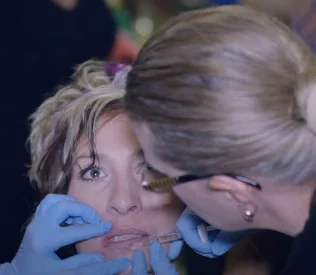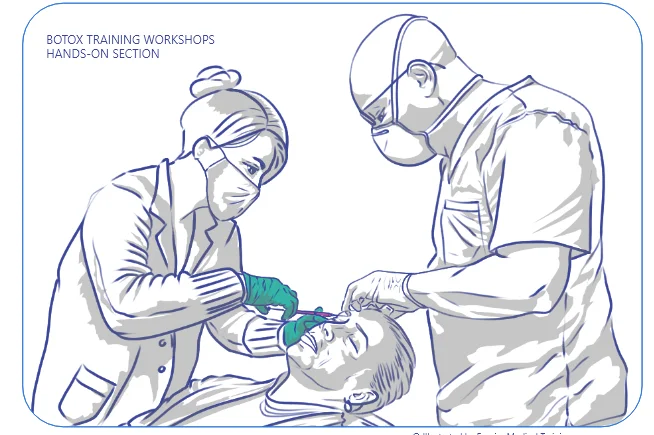Botox® Class
Neurotoxins | March 31, 2021

Botox® Class
Entry made by
Empire Medical Training
Botox® is a common cosmetic treatment because it is relatively easy for trained medical professionals to administer via outpatient care, because it is affordable for patients and providers alike, and because it produces durable
results within days of injection.
Increasingly, Botox is sought by patients seeking relief for certain non-cosmetic medical conditions, including cervical dystonia (painful involuntary
movements of the neck) and chronic migraine. Therapeutic Botox injections provide lasting improvements in subjective pain measurements and overall quality of life for countless patients.
While Botox is safe for patients
when properly administered by trained professionals, it is important to remember that the medication itself is derived from one of the deadliest known neurotoxins. Improper injection procedure or injection in defiance of clear
contraindications greatly increases the risk of serious and sometimes fatal complications. Any provider wishing to add Botox to their practice must complete an accredited Botox certification course that covers patient anatomy,
patient evaluation and treatment planning, Botox handling and safety guidance, and basic injection training.
What to Expect From an Accredited Botox Class
An accredited introductory Botox certification program typically includes one to two full days of didactic and hands-on instruction featuring live volunteers. Upon successful completion, trainees will be prepared to manage a Botox practice and perform basic cosmetic injections and therapeutic injections. In addition to Botox treatment procedures for specific conditions, class instruction should touch upon topics such as:

- Understanding the physiological effects and pharmacokinetics of botulinum toxin
- How to evaluate treatment candidates and identify possible contraindications for Botox and other medications derived from botulinum toxin
- Understanding the differences between Botox and Botox competitors like Xeomin and Juveau
- How to develop unique treatment plans for individual patients
- How to reconstitute and dilute Botox before treatment
- How to identify and correct undesirable outcomes and complications of treatment
- Understanding oral and maxillofacial anatomy at the micro level
- How and where to purchase Botox and Botox competitors
- How to effectively market and price Botox treatments and related services, including other popular cosmetic procedures
Procedures Learned in Botox Classes
The “main event” of any accredited Botox course is thorough, hands-on instruction in a range of common Botox treatments. More advanced classes cover bespoke treatments that require more experience, but the focus remains the same. The best Botox
classes always include live procedural demonstrations using human volunteers recruited by the class sponsor or brought by individual class participants. Demonstrations that do not involve human volunteers should occur only
on life-size, anatomically correct mannequins or busts.
Because the full list of FDA-approved Botox procedures continues to grow, it is important for clinicians planning to enroll in a Botox
class to consider the types of treatments and services they plan to offer in their practice. Determining whether to offer only aesthetic medicine/cosmetic or only therapeutic Botox services — or both — is especially important.
A cosmetic-only course may be preferable for aesthetic practices that do not plan to offer treatments for non-cosmetic conditions.
Botox classes that primarily cover cosmetic Botox should provide instruction in the
following conditions and procedures:
- Glabellar lines
- Horizontal forehead lines
- Eyebrow lift
- Crows’ feet
- Gummy or “sad” smile”
- Marionette lines
- Bunny lines
- Vertical lip lines (smokers’ lines)
Botox classes that cover medical or therapeutic Botox injections should discuss the following conditions and procedures:
- Cervical dystonia
- Bruxism (involuntary jaw clenching) and TMJ disorders
- Chronic migraine
- Hyperhidrosis (excessive sweating)
- Urinary incontinence and other bladder conditions indicated for Botox treatment
- Limb spasticity
Botox Class Example: Empire Medical Training’s Workshop for Licensed Medical Professionals
Empire Medical Training’s Botox workshop is an accredited continuing medical education course for healthcare professionals, such as nurse practitioners, doctors, and dentists, who wish to integrate Botox into their practices. It is a useful example of the sort of comprehensive, high-quality Botox class that practitioners should consider, and with hundreds of sessions completed over two decades, its results speak for itself.
Prerequisites for EMT’s Botox Class
Most accredited Botox classes require participants to collect prerequisites before their class date, and EMT’s basic Botox class is no exception. Empire Medical Training recommends or requires (depending on clinician type) its attendees to complete a
comprehensive facial anatomy class known as the Advanced Facial Anatomy Cadaver Workshop for Aesthetics. This program, which is also run by EMT, provides detailed facial anatomy instruction and is designed to help Botox clinicians
avoid complications, poor treatment outcomes, and possible legal or malpractice claims that may arise from these issues.
The Advanced Facial Anatomy Cadaver Workshop for Aesthetics is available as an on-demand video workshop for Empire Medical Training members or as a live in-person workshop at two convenient locations: Rosalind Franklin University (near Chicago) and Columbia University
(in New York City). Both versions of the workshop confer nine AMA PRA CME credits and completion certificates to all successful workshop graduates.
What EMT’s Botox Class Tuition Includes
TThe Empire Medical Training Botox treatment class is especially popular because it delivers exceptional value compared with comparable accredited workshops. Tuition covers:
- Training on live patient volunteers, either brought by the participant or paired by EMT upon request. Volunteers are not required to pay for any cosmetic treatments received during the training session.
- Botox or other neurotoxin products to inject one volunteer patient, with additional product available for purchase at EMT’s cost.
- Workshop presentations and all other course materials
- Editable treatment protocols for use in clinic
- Instruction videos on Botox treatment techniques and methods not included in the course itself, as well as instruction videos for other common cosmetic treatments
- Licensing rights to EMT’s before and after treatment photos
- EMT’s practice marketing materials with limited use license
- Essential office documents and templates for aesthetic practices, such as patient intake and consent forms
Avoiding Non-Accredited Botox Classes
Clinicians should pay close attention to accreditation status when evaluating Botox classes and limit selection only to accredited Botox course providers. Non-accredited training providers’ instruction may not be as comprehensive as necessary to ensure above-standard treatment and may not meet minimum regulatory standards enforced by state medical authorities. This may result in clinicians operating in a legal gray area or even outside the law with potentially adverse long-term consequences for their practices or finances.


